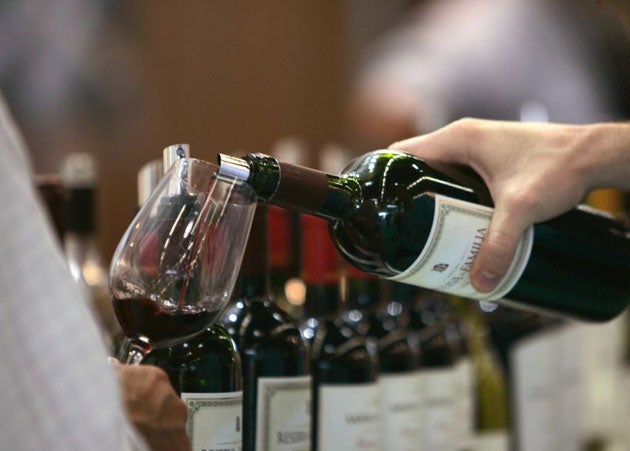The electronic tongue with a taste for fine wine

Your support helps us to tell the story
From reproductive rights to climate change to Big Tech, The Independent is on the ground when the story is developing. Whether it's investigating the financials of Elon Musk's pro-Trump PAC or producing our latest documentary, 'The A Word', which shines a light on the American women fighting for reproductive rights, we know how important it is to parse out the facts from the messaging.
At such a critical moment in US history, we need reporters on the ground. Your donation allows us to keep sending journalists to speak to both sides of the story.
The Independent is trusted by Americans across the entire political spectrum. And unlike many other quality news outlets, we choose not to lock Americans out of our reporting and analysis with paywalls. We believe quality journalism should be available to everyone, paid for by those who can afford it.
Your support makes all the difference.Can't tell the difference between paint stripper and a 1982 Château Pétrus? Well, scientists have developed a remedy: an "electronic tongue" that can distinguish between grape varieties and vintages.
The device is still in the early stages of development but researchers hope they will one day be able to make an automatic wine taster that is more reliable than the human palette.
The electronic tongue – or e-tongue – is based on an array of tiny synthetic membranes built on to a single silicon chip called a multisensor. Each membrane has a different sensitivity to the various chemical components that distinguish one grape variety from another and one wine vintage from the next.
It can already distinguish between four grape varieties – Airén, Chardonnay, Malvasia and Macabeu – and samples of the same wine belonging to the vintage years 2004 and 2005.
"The results have demonstrated the potential of using those multisensors as electronic tongues not only for distinguishing the samples according to the grape variety and the vintage year, but also for quantitative prediction of several sample parameters," said Cecilia Jiménez-Jorquera, of the Barcelona Institute of Microelectronics.
The scientists hope that by extending the range of chemicals the e-tongue can distinguish, it will be able to identify substances or additives that could affect wine quality or indicate wine fraud.
Dr Jiménez-Joquera said the device is based on similar principles to the human tongue and is sensitive to just five different tastes: sweet, salty, bitter, acidic and umami (savoury). The scientists tested the device on nine samples of grape juice from the 2005 vintage and six samples from 2004. They tested it again seven months later on wines made from the four grape varieties from the two vintages, according to a study published in the Royal Society of Chemistry journal The Analyst.
Dr Jiménez-Jorquera and her colleagues said the device is simple to use and can be made portable so that wine samples can be tested on site.
Dr Susan Ebeler, of the University of California, Davis, who has studied the chemistry of wine flavour, said the device would be fast and relatively cheap and easy to use. "One of the most interesting aspects is the ability to predict sugar, acid and alcohol content using sensors that are not specifically sensitive to these components," said Dr Ebeler.
A huge effort is also under way to develop machines that can sniff out molecules from the air. These "electronic noses" have been pioneered by Nasa, as well as the security industry, both of which are eager to automate the process of detecting explosives.
The wine-maker's holy grail
By Anthony Rose
From checking airline passengers for traces of explosives to undermining the efforts of wine critics to make sense of wine tasting, the development of an e-tongue or e-nose has any number of potential uses beyond the stated objective of measuring aromas and flavours in wine.
Like latter-day alchemists, white-coated boffins in research departments around the world have long been in search of the ultimate cybernose. When they find the holy e-grail, the first person who'll pay a lot of money for its services will be one William I Koch.
Mr Koch is the American billionaire who has spent a small fortune suing Hardy Rodenstock, a German pop impresario, in an attempt to prove that the four 18th-century bottles of wine supposedly belonging to Thomas Jefferson, for which he paid $500,000, are in fact fakes. So far to little avail, as the expert witnesses can't agree.
Given the escalating cost of luxury wines such asRomanée-Conti, Pétrus, Le Pin, Yquem and Lafite and the vast sums the new rich are prepared to shell out for them, it's hardly surprising that wine counterfeiting is big business. It's relatively simple to create a fake label but very hard to detect.
The fine-wine industry has belatedly woken up to the potential for wine fraud with special inks, bottles, marks on bottles and labels sensitive to UV light, holograms, bar codes and limited edition among measures employed to protect themselves and their customers from fraud.
Temperature-tracking tags are a recent innovation while the Australian wine company, Hardy, uses genetic vine material in neck seals to keep track of its more precious bottlings.
The e-tongue or its nasal equivalent may have its uses in the generalities of sifting grape variety or wine by country, but whether it will be able to hardwire the finer points of Château Lafite or Mouton-Rothschild to our brains is another matter. Besides, are you prepared to lavish an expensive bottle on a robot?
Join our commenting forum
Join thought-provoking conversations, follow other Independent readers and see their replies
Comments